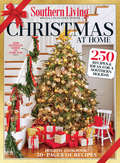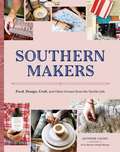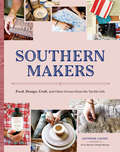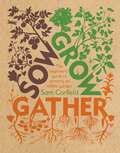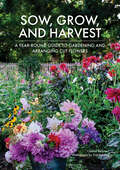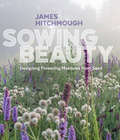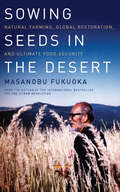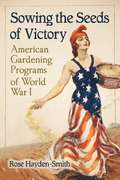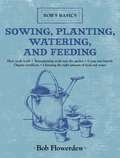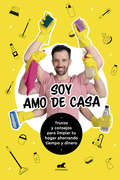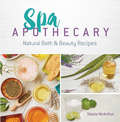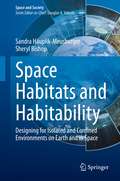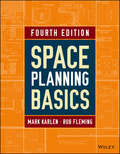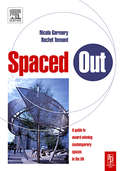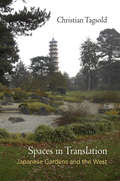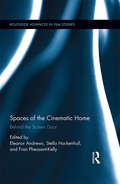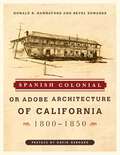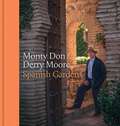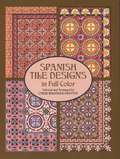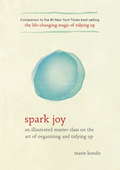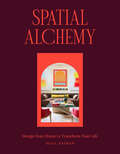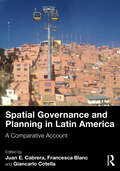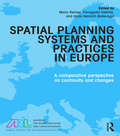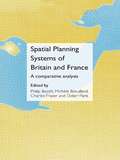- Table View
- List View
Southern Living: 250 Ideas to Design Your Dream Home
by The Editors of Southern LivingIn celebration of Southern Living's 50th anniversary, this keepsake issue is full of decorating and design ideas for creating timeless Southern homes. We take readers on a tour of our all-time best Idea Houses, and share the most inspiring and beautiful rooms and spaces we've published in 50 years.
Southern Living: 250 Recipes & Ideas for a Southern Holiday
by The Editors of Southern Living250 recipes and tips for an unforgettable holiday, Southern style! In the South, Christmas means family and elegant celebrations that create memories for a lifetime. Southern Living Christmas at Home gathers the best ideas for holiday celebrations from the beloved magazine dedicated to America's South.
Southern Makers
by Jennifer CauseyIn this follow-up to our bestselling Brooklyn Makers, photographer Jennifer Causey returns to her Southern roots to introduce us to a group of artisans with a long tradition of craftsmanship and a wonderfully vibrant cultural history. In communities across the South, amidst breathtaking country landscapes and bustling city neighborhoods, a thriving creative revival is underway. In Southern Makers, Causey captures the spirit of this movement by documenting twenty-five of the area's most celebrated craftspeople. This eclectic mix of established and up-and-coming makers includes bakers, textile artists, denim designers, jewelers, woodworkers, brewers, farmers, and more. Causey's photographs are suffused with Southern charm as she explores the artisans' spaces, from restored homes and old factories to repurposed gas stations, general stores, and flowering fields. These lively interviews reveal personal inspirations and motivations, along with heartfelt reflections on the place where they live and work.
Southern Makers: Food, Design, Craft, and Other Scenes from the Tactile Life
by Jennifer CauseyIn this follow-up to our bestselling Brooklyn Makers, photographer Jennifer Causey returns to her Southern roots to introduce us to a group of artisans with a long tradition of craftsmanship and a wonderfully vibrant cultural history. In communities across the South, amidst breathtaking country landscapes and bustling city neighborhoods, a thriving creative revival is underway. In Southern Makers, Causey captures the spirit of this movement by documenting twenty-five of the area's most celebrated craftspeople. This eclectic mix of established and up-and-coming makers includes bakers, textile artists, denim designers, jewelers, woodworkers, brewers, farmers, and more. Causey's photographs are suffused with Southern charm as she explores the artisans' spaces, from restored homes and old factories to repurposed gas stations, general stores, and flowering fields. These lively interviews reveal personal inspirations and motivations, along with heartfelt reflections on the place where they live and work.
Sow Grow Gather: The Beginner’s Guide to Growing an Edible Garden
by Sam CorfieldNo matter how small your space, green-fingered Sam Corfield (aka The Hairy Horticulturist) shows you how simple it is to grow your own edible garden.Covering over 50 roots, shoots, flowers, leaves and fruits, he’ll guide you through his foolproof three-step method of sow–grow–gather, while providing useful tips and tricks along the way. Showcasing delicious vegetables, fruits and herbs that anyone can easily grow at home, Sam will also introduce you to some more unusual and colourful veggies (like purple carrots, rainbow radishes and cucamelons!) to show just how exciting growing-your-own can be.Whether you have a small garden, balcony or windowsill, Sow Grow Gather will demystify the growing process, explain useful gardening equipment and reveal how to fit different containers and pots into every corner of your space. With beautiful photography and advice on which plants will suit your plot, as well as how to care for them, you’ll go from veg-patch beginner to edible-garden-expert in no time, and have fun during the process.
Sow, Grow, and Harvest: A Year-Round Guide to Gardening and Arranging Cut Flowers
by Chantal RemmertDirty hands, naturally grown plants, and a wild sea of flowers—all these characterize Sow, Grow, and Harvest: A Year-Round Guide to Gardening and Arranging Cut Flowers. Readers will learn to sow, grow, and harvest flowers, working year-round in their own gardens and home nurseries! As documented through the evocative lens of photographer Grit Hartung, Chantal Remmert presents a year in her nursery, laden with comprehensive step-by-step instructions. With practical DIYs and a program for every season—from sowing to cultivating, from harvesting and arranging ornate bouquets to overwintering plants—this book is a fundamental source for gardening beginners and seasoned flower enthusiasts alike. Key Features:Comprehensive DIYs covering all four seasons: Detailed projects for every season to nurture a garden and home nursery year-round, such as making willow tea, drying flowers, and creating indoor warming trays for plants.Practical tips: Easy-to-follow recommendations for sowing, cultivating, and harvesting, including guidance on select flower species such as tulips, dahlias, snapdragons, cosmos, and peonies.Sustainable techniques: Eco-friendly methods for selecting materials, gardening, composting, and creating beautiful, lasting bouquets.Evocative and practical photography: Gorgeous images that capture the essence of wild gardens and untamed flowers, while also providing a practical visual aid. An enchanting guide for those who find joy in the simple pleasures of cultivating and arranging flowers.
Sowing Beauty: Designing Flowering Meadows from Seed
by James Hitchmough“A hopeful and expansive book for the gardener who sees a field as a canvas.” —Publishers Weekly James Hitchmough is well-regarded in the design world for his exuberant, colorful, and flower-filled meadows. His signature style can be seen in prominent places like London’s Olympic Park and the Botanic Garden at the University of Oxford. Using a distinct technique of sowing meadows from seed, he creates plant communities that mimic the dramatic beauty of natural meadows and offer a succession of blooms over many months—a technique that can be adapted to work in both large-scale public gardens and smaller residential gardens. Sowing Beauty shows you how to recreate Hitchmough’s masterful, romantic style. You'll will learn how to design and sow seed mixes that include a range of plants, both native and exotic, and how to maintain the sown spaces over time. Color photographs show not only the gorgeous finished gardens, but also all the steps along the way.
Sowing Seeds in the Desert: Natural Farming, Global Restoration, and Ultimate Food Security
by Masanobu Fukuoka"This is what all of humanity has to learn to do, whether it is in economic desert created by Wall Street, or an ecological desert created by globalized corporate agriculture."—Vandana Shiva, founder of Navdanya Research Foundation for Science Technology & EcologyThe earth is in great peril, due to the corporatization of agriculture, the rising climate crisis, and the ever-increasing levels of global poverty, starvation, and desertification on a massive scale. This present condition of global trauma is not &“natural,&” but a result of humanity&’s destructive actions. And, according to Masanobu Fukuoka, it is reversible. We need to change not only our methods of earth stewardship, but also the very way we think about the relationship between human beings and nature.Fukuoka grew up on a farm on the island of Shikoku in Japan. As a young man he worked as a customs inspector for plants going into and out of the country. This was in the 1930s when science seemed poised to create a new world of abundance and leisure, when people fully believed they could improve upon nature by applying scientific methods and thereby reap untold rewards. While working there, Fukuoka had an insight that changed his life forever. He returned to his home village and applied this insight to developing a revolutionary new way of farming that he believed would be of great benefit to society. This method, which he called &“natural farming,&” involved working with, not in opposition to, nature.Fukuoka&’s inspiring and internationally best-selling book, The One-Straw Revolution was first published in English in 1978. In this book, Fukuoka described his philosophy of natural farming and why he came to farm the way he did. One-Straw was a huge success in the West, and spoke directly to the growing movement of organic farmers and activists seeking a new way of life. For years after its publication, Fukuoka traveled around the world spreading his teachings and developing a devoted following of farmers seeking to get closer to the truth of nature.Sowing Seeds in the Desert, a summation of those years of travel and research, is Fukuoka&’s last major work-and perhaps his most important. Fukuoka spent years working with people and organizations in Africa, India, Southeast Asia, Europe, and the United States, to prove that you could, indeed, grow food and regenerate forests with very little irrigation in the most desolate of places. Only by greening the desert, he said, would the world ever achieve true food security.This revolutionary book presents Fukuoka&’s plan to rehabilitate the deserts of the world using natural farming, including practical solutions for feeding a growing human population, rehabilitating damaged landscapes, reversing the spread of desertification, and providing a deep understanding of the relationship between human beings and nature. Fukuoka&’s message comes right at the time when people around the world seem to have lost their frame of reference, and offers us a way forward.Sowing Seeds in the Desert will persuade any reader that the imperiled living world is our greatest teacher, and inspire them to care for it as vigorously as Fukuoka has.&”—Toby Hemenway, author of Gaia's Garden
Sowing the Seeds of Victory: American Gardening Programs of World War I
by Rose Hayden-SmithSometimes, to move forward, we must look back. Gardening activity during American involvement in World War I (1917-1919) is vital to understanding current work in agriculture and food systems. The origins of the American Victory Gardens of World War II lie in the Liberty Garden program during World War I. This book examines the National War Garden Commission, the United States School Garden Army, and the Woman's Land Army (which some women used to press for suffrage). <P><P> The urgency of wartime mobilization enabled proponents to promote food production as a vital national security issue. The connection between the nation's food readiness and national security resonated within the U.S., struggling to unite urban and rural interests, grappling with the challenges presented by millions of immigrants, and considering the country's global role. The same message--that food production is vital to national security--can resonate today. These World War I programs resulted in a national gardening ethos that transformed the American food system.
Sowing, Planting, Watering, and Feeding: Bob's Basics (Bob's Basics)
by Bob FlowerdewYou most likely already know that nurturing a planted seed is necessary for growing a healthy plant. But how do you know the right amount of water to give? What are the best kinds of organic fertilizers? How can you plant a seed to set it on the right track for optimal growth? In Sowing, Planting, Watering, and Feeding, Bob Flowerdew guides you through these and other quandaries, and provides practical advice for dodging common mistakes gardeners make when nurturing their seedlings.
Soy Amo de Casa: Trucos y consejos para limpiar tu hogar ahorrando tiempo y dinero
by Soy Amo de CasaAprendé a limpiar organizadamente con productos hechos por vos y convertí tu casa en tu lugar en el mundo. Tu casa debería ser un lugar al quieras volver siempre. Y para eso, además de ordenada, tiene que estar limpia. Soy Amo de Casa te muestra las mejores estrategias para lograrlo, a la vez que te enseña cómo hacer tus propios productos de limpieza con solo dos o tres ingredientes. ¿Sabías que el vinagre hace magia? ¿A qué tenés que dedicarle más atención y con qué frecuencia? ¿Qué podés hacer con esa mancha que no sale con nada? ¿Y con el sarro de la bañera? ¿Es posible recuperar una olla quemada o dejar impecable una pava? ¿Hay una forma eficaz de limpiar azulejos y pisos? ¿Cómo lograr que la ropa no quede arrugada? ¿Cómo quitarles el olor a las zapatillas? Soy Amo de Casa es tu aliado perfecto. El experto que te ayudará a transformar tu casa en tu lugar en el mundo.
Spa Apothecary: Natural Bath & Beauty Recipes
by Stasie McArthurYou can make luxurious products for skin, hair, and bath at home! All you need are basic cooking skills, a few simple kitchen tools, some common household ingredients — and this easy-to-follow guide. Spa Apothecary is a great resource for those who want to avoid the chemical additives of commercial products. Best of all, it will assist you in transitioning to a healthier, natural beauty routine and save you money, too!Author Stasie McArthur explains how to build your own personal apothecary. There is a supply list and more than 100 simple, preservative-free recipes, along with a helpful tip for each one. Included are moisturizers and toners for face and hand care, washes and scrubs for skin and body, shampoos and conditioners, and healing compounds for congestion and earaches. These handmade products make great gifts for family and friends — and can be customized with favorite scents and textures.
Space Habitats and Habitability: Designing for Isolated and Confined Environments on Earth and in Space (Space and Society)
by Sandra Häuplik-Meusburger Sheryl BishopThis book explores creative solutions to the unique challenges inherent in crafting livable spaces in extra-terrestrial environments. The goal is to foster a constructive dialogue between the researchers and planners of future (space) habitats. The authors explore the diverse concepts of the term Habitability from the perspectives of the inhabitants as well as the planners and social sciences.The book provides an overview of the evolution and advancements of designed living spaces for manned space craft, as well as analogue research and simulation facilities in extreme environments on Earth. It highlights how various current and future concepts of Habitability have been translated into design and which ones are still missing. The main emphasis of this book is to identify the important factors that will provide for well-being in our future space environments and promote creative solutions to achieving living spaces where humans can thrive. Selected aspects are discussed from a socio-spatial professional background and possible applications are illustrated.Human factors and habitability design are important topics for all working and living spaces. For space exploration, they are vital. While human factors and certain habitability issues have been integrated into the design process of manned spacecraft, there is a crucial need to move from mere survivability to factors that support thriving. As of today, the risk of an incompatible vehicle or habitat design has already been identified by NASA as recognized key risk to human health and performance in space. Habitability and human factors will become even more important determinants for the design of future long-term and commercial space facilities as larger and more diverse groups occupy off-earth habitats. The book will not only benefit individuals and organizations responsible for manned space missions and mission simulators, but also provides relevant information to designers of terrestrial austere environments (e.g., remote operational and research facilities, hospitals, prisons, manufacturing). In addition it presents general insights on the socio-spatial relationship which is of interest to researchers of social sciences, engineers and architects.
Space Planning Basics
by Mark Karlen Rob FlemingConquer the complexity of interior design with a logical, methodical approach Space Planning Basics is a definitive introduction and principle resource for thousands of designers. With step-by-step methodology based on the author's several decades of design experience, this authoritative guide has become the de facto reference for an entire generation of designers. This updated fourth edition includes digitized drawings, diagrams, and matrices throughout, and newly added supplemental photographs. The text has been revised to reflect the latest developments in sustainable and universal design, including coverage of daylighting, benchmarking, LEED system standards, and green code issues. The companion website provides AutoCAD files, intrustor videos and matrices to give you a deeper real-world understanding of the design process. This book is perfect preparation for the NCIDQ exam. Proper space planning goes way beyond sketching a preliminary floor plan. Successful implementation includes a balanced integration of code compliance, system support, and adherence to the client's functional needs. Sustainability adds a new, important layer of complexity. This book shows you how to approach space planning in a way that ensures all considerations are met, and nothing gets lost in the process. Adopt an organized and comprehensive planning methodology Work effectively with dimensionally challenging spaces Consider building systems, codes, lighting, acoustics, and more Develop advanced skills and conquer new challenges Space planning encompasses many components and processes, making a comprehensive reference necessary for mastery of the field. Space Planning Basics is a thorough, methodical resource that gets you started on the right track, with plenty of room for creativity.
Spaced Out
by Rachel Tennant Nicola GarmoryThis beautifully illustrated guide celebrates some of the most significant award winning public spaces in major cities in the UK and Ireland over the last ten years.Dealing with a range of contemporary and innovating designed landscapes from urban spaces to public parks, this book focuses on those that have been awarded the highest design accolade from the Royal Institute of British Architects, The Royal Town andPlanning Institute, The Landscape Institute and The Civic Trust. Focusing on designs in ten major cities, and providing a snappy synopsis of each of the spaces in terms of its design statement, function, location, design team and award commentary, It illustrates tothe reader what makes 'good design' in the public realm, providing both information and inspiration.
Spaces in Translation: Japanese Gardens and the West
by Christian TagsoldOne may visit famous gardens in Tokyo, Kyoto, or Osaka—or one may visit Japanese-styled gardens in New York, San Francisco, Philadelphia, Berlin, London, Paris, São Paulo, or Singapore. We often view these gardens as representative of the essence of Japanese culture. Christian Tagsold argues, however, that the idea of the Japanese garden has less do to with Japan's history and traditions, and more to do with its interactions with the West.The first Japanese gardens in the West appeared at the world's fairs in Vienna in 1873 and Philadelphia in 1876 and others soon appeared in museums, garden expositions, the estates of the wealthy, and public parks. By the end of the nineteenth century, the Japanese garden, described as mystical and attuned to nature, had usurped the popularity of the Chinese garden, so prevalent in the eighteenth century. While Japan sponsored the creation of some gardens in a series of acts of cultural diplomacy, the Japanese style was interpreted and promulgated by Europeans and Americans as well. But the fashion for Japanese gardens would decline in inverse relation to the rise of Japanese militarism in the 1930s, their rehabilitation coming in the years following World War II, with the rise of the Zen meditation garden style that has come to dominate the Japanese garden in the West.Tagsold has visited over eighty gardens in ten countries with an eye to questioning how these places signify Japan in non-Japanese geographical and cultural contexts. He ponders their history, the reasons for their popularity, and their connections to geopolitical events, explores their shifting aesthetic, and analyzes those elements which convince visitors that these gardens are "authentic." He concludes that a constant process of cultural translation between Japanese and Western experts and commentators marked these spaces as expressions of otherness, creating an idea of the Orient and its distinction from the West.
Spaces of the Cinematic Home: Behind the Screen Door (Routledge Advances in Film Studies #42)
by Stella Hockenhull Eleanor Andrews Fran Pheasant-KellyThis book examines the ways in which the house appears in films and the modes by which it moves beyond being merely a backdrop for action. Specifically, it explores the ways that domestic spaces carry inherent connotations that filmmakers exploit to enhance meanings and pleasures within film. Rather than simply examining the representation of the house as national symbol, auteur trait, or in terms of genre, contributors study various rooms in the domestic sphere from an assortment of time periods and from a diversity of national cinemas—from interior spaces in ancient Rome to the Chinese kitchen, from the animated house to the metaphor of the armchair in film noir.
Spanish Colonial or Adobe Architecture of California: 1800-1850
by Donald R. Hannaford Revel EdwardsIn California, authentic Spanish colonial houses were built with local materials for comfort and convenience, with both construction and ornamentation traditional of Spanish and New England settlers. This book gives architects, home builders and historians a chance to view photos, sketches, and twenty-six full pages of measured drawings of interior and exterior doorways, paneling, balconies, wrought-iron, and mantels—most from houses that are no longer standing.
Spanish Gardens
by Monty Don Derry MooreFor over a decade, Monty Don has travelled the world, using gardens and green spaces to get under the skin of our most beloved cities and countries. Many of his destinations were well-known to him. For his latest journey, though, he explored Spain as a relative newcomer - and he kept a detailed record of his travels.Starting in Madrid and working his way north through the verdant gardens of Galicia, the Basque country and Barcelona, Monty then heads south to the rugged tropical climes of Mallorca, Alicante, Andalucia, Malaga, and Seville. It's a chance for him to explore how Spain has evolved from the darker days after the civil war to its successful transition to democracy over fifty years ago, tracing those changes through its gardens - from the more conventional gardens created after the war to the rich and inventive approaches of contemporary designers.Accompanied by Derry Moore's stunning photography, Spanish Gardens is a remarkable and personal journey through one of the most popular country destinations on earth.
Spanish Tile Designs in Full Color
by Carol Belanger GraftonSelected from rare l9th- and early-20th-century manufacturers' catalogs, the 97 full-color tile designs in this splendid collection display a host of patterns, many revealing striking Moorish influence. Predominantly blue, green, red, and brown with white backgrounds, the tiles incorporate stylized flowers, leaves, and other plant forms, abstract and geometric figures, stars, and suns.
Spark Joy: An Illustrated Master Class on the Art of Organizing and Tidying Up (The Life Changing Magic of Tidying Up)
by Marie KondoJapanese decluttering guru Marie Kondo's The Life-Changing Magic of Tidying Up has revolutionized homes--and lives--across the world. Now, Kondo presents an illustrated guide to her acclaimed KonMari Method, with step-by-step folding illustrations for everything from shirts to socks, plus drawings of perfectly organized drawers and closets. She also provides advice on frequently asked questions, such as whether to keep "necessary" items that may not bring you joy. With guidance on specific categories including kitchen tools, cleaning supplies, hobby goods, and digital photos, this comprehensive companion is sure to spark joy in anyone who wants to simplify their life.From the Hardcover edition.
Spatial Alchemy: Design Your Home to Transform Your Life
by Olga NaimanA beautifully illustrated guide to harnessing interior design as a tool for personal transformation. What if your home could change your life? Starting with a radically simple idea—that we are shaped by the spaces we inhabit—Olga Naiman reveals her unique step-by-step road map for personal empowerment and evolution through home design. Like the ancient alchemists, she&’ll teach you the secrets of shaping the mundane into the magical—so you can begin to uncover and then manifest what you truly want in life. Then you&’ll begin the process of mindfully designing your space to better serve your personal goals, support your emotional needs, and offer comfort to your body and mind. Along the way, you'll learn to: ·Harness the power of color, texture, and symbolism to shift the energy in your home. ·Choose an &“emotional regulation chair&” to invite softness and ease at the end of a challenging day. ·Create an altar to your Future Self. ·Discover how certain objects can have a profound effect on both your psyche and your space. ·And so much more! Through this one-of-a-kind journey, you&’ll create a home that&’s beautiful, functional, and deeply personal—to set yourself on a path to a life filled with more meaning and pleasure.
Spatial Governance and Planning in Latin America: A Comparative Account
by Giancarlo Cotella Juan E. Cabrera Francesca BlancThis book is the first to provide an in-depth discussion of spatial governance and planning systems (SGPSs) in Latin America, with analysis and comparison across 10 different countries: Argentina, Bolivia, Brazil, Chile, Colombia, Cuba, Ecuador, Mexico, Peru, and Uruguay. The primary function of SPGSs is to empower the public sector to exert control over spatial development. Originally understood mainly through a legal paradigm, it is now acknowledged that a range of informal institutions also play a role, responding to societal and community needs that the state or market is unable to address. This collection teases out these contrasting influences, highlighting the role of indigenous culture in certain contexts, and the increase of participatory processes in others. The book features not only individual country case studies, but also chapters discussing the broader themes, as well as how the Latin American context compares to the European one. A timely contribution to this evolving topic, the book will appeal to students and scholars in the fields of planning, urban and regional studies, public policy, and human geography.
Spatial Planning Systems and Practices in Europe: A Comparative Perspective on Continuity and Changes
by Mario Reimer Panagiotis Getimis Hans Heinrich BlotevogelIdeal for students and practitioners working in spatial planning, the Europeanization of planning agendas and regional policy in general Spatial Planning Systems and Practices in Europe develops a systematic methodological framework to analyze changes in planning systems throughout Europe. The main aim of the book is to delineate the coexistence of continuity and change and of convergence and divergence with regard to planning practices across Europe. Based on the work of experts on spatial planning from twelve European countries the authors underline the specific and context-dependent variety and disparateness of planning transformation, focusing on the main objectives of the changes, the driving forces behind them and the main phases and turning points, the main agenda setting actors, and the different planning modes and tools reflected in the different "policy and planning styles". Along with a methodological framework the book includes twelve country case studies and the comparative conclusions covering a variety of planning systems of EU member states. According to the four "ideal types" of planning systems identified in the EU Compendium, at least two countries have been selected from each of the four different planning traditions: regional-economic (France, Germany), Urbanism (Greece, Italy), comprehensive/integrated (Denmark ,Finland, Netherlands, Germany), "land use planning" (UK, Czech Republic, Belgium/Flanders), along with two additional case studies focusing on the recent developments in eastern European countries by looking at Poland and in southern Europe looking at Turkey.
Spatial Planning Systems of Britain and France: A Comparative Analysis
by Philip Booth Charles Fraser Michèle Breuillard Didier ParisSpatial Planning Systems of Britain and France brings together a wide selection of comparative essays to highlight the fundamental similarities and differences between the spatial planning in Great Britain and France: two countries that are near neighbours and yet have developed very different modes of planning in terms of their structure, practical application and underlying philosophies. Drawing on the outcomes of the Franco-British Planning Study Group and with a foreword by Vincent Renard of the Ecole Polytechnique in Paris, the book offers a comparative investigation of the basic contexts for planning in both countries, including its administrative, economic, financial and legal implications, and then move on to illustrate themes such as urban policy and transport planning through detailed analysis and case studies. From these investigations the book brings together planning concepts from both a national and European perspective, looking particularly at two current issues: the effects of urban growth on small market towns and the use of Public-Private partnerships to implement development projects. Spatial Planning Systems of Britain and France will prove invaluable to policy makers and practitioners in both countries at a time when national policy is beginning to look towards practice in other countries. The book is published simultaneously in English and French opening up a wider debate between the English-speaking and francophone worlds.

